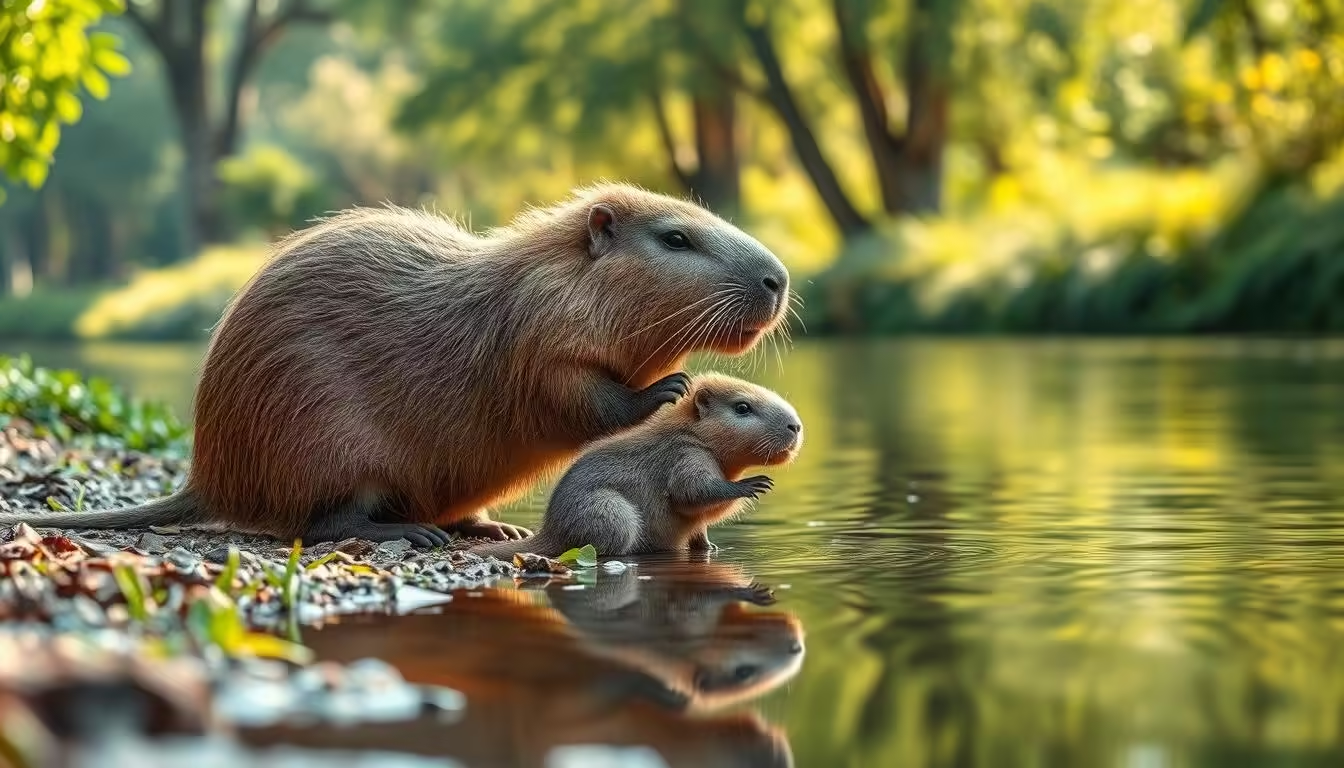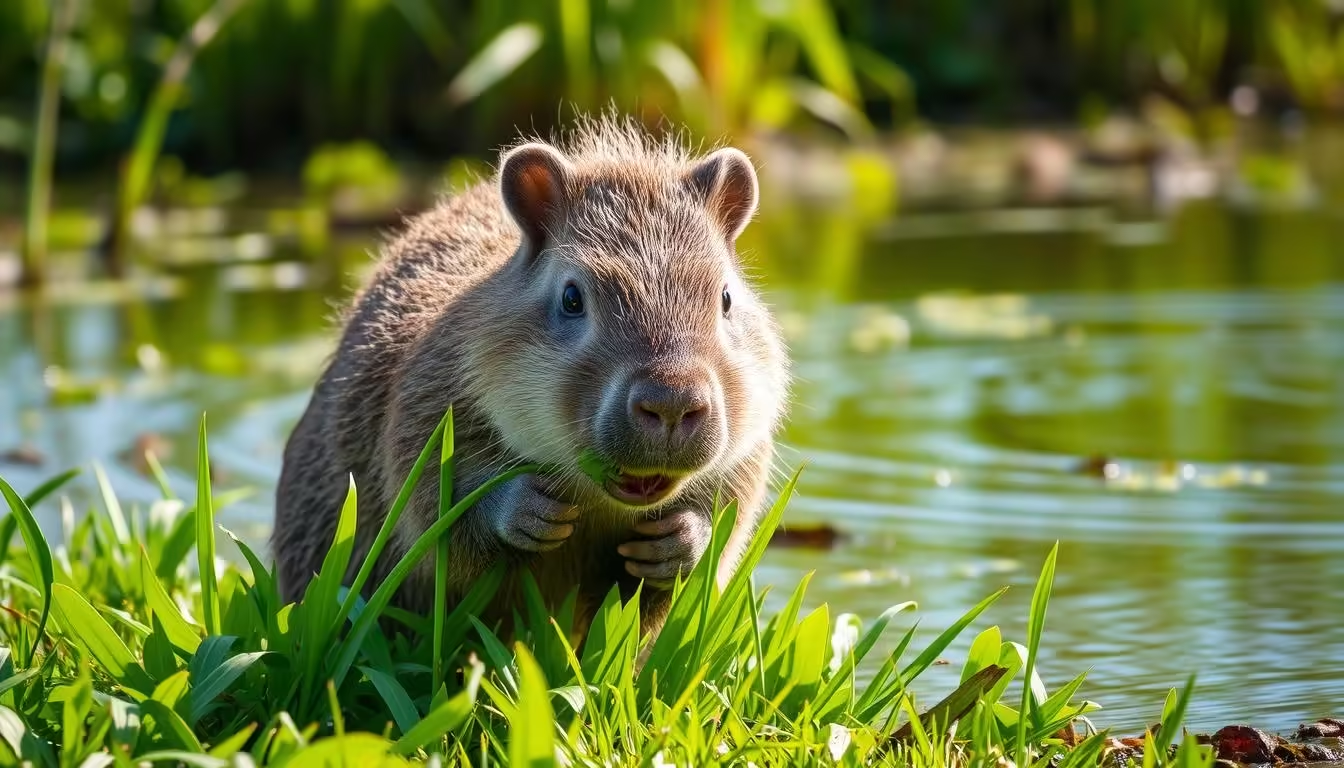The young Capybaras have a tough time surviving, with an average lifespan of just four years. They must avoid predators like jaguars, cougars, and caimans.
Their digestive system is very sensitive, making it hard for young capybaras to thrive. They live in groups of 10 to 20, which can make them more vulnerable to predators. During the dry season, these groups can grow to 100 individuals.
Key Takeaways:
- Capybara infants face a high mortality rate in their natural habitats, with only 1 in 20 baby capybaras surviving to adulthood.
- The capybara’s sensitive digestive system and the presence of numerous predators contribute to their high infant mortality.
- Capybaras are highly social animals, living in groups that can increase in size during the dry season, making them more vulnerable to predation.
- The average lifespan of a wild capybara is only around four years, significantly shorter than their 8-10-year lifespan in captivity.
- Understanding the factors that contribute to baby capybara mortality is crucial for conservation efforts and ensuring the survival of this unique rodent species.
Group Structure and Social Organization
Capybaras are very social, living in groups of 10 to 40. They have adult males, females, and young ones. Each plays a key role in the group’s health. They use scent glands to mark territory and talk to each other, keeping the group tight.
Territory and Habitat Requirements
A capybara group’s home is about 10 hectares in size. They need water for swimming and plants for eating. Capybaras are great swimmers, staying underwater for up to five minutes.
Natural Population Fluctuations
Many things affect capybara numbers in the wild. Food, water, shelter, and predators all play a part. Knowing these changes helps us protect and manage capybara populations better.
“Capybaras are truly remarkable creatures, adapting seamlessly to their lush, water-rich environments and thriving in their close-knit social groups.”
Predator Threats to Baby Capybaras
The capybara, the world’s largest rodent, faces many dangers when it’s young. Baby capybaras are hunted by many predators in their South American homes. Jaguars, cougars, harpy eagles, caimans, green anacondas, and piranhas are all threats.
These predators make it hard for young capybaras to survive. They have a short life in the wild, living only about four years. This shows how dangerous their world is from the start.
| Predator | Threat to Baby Capybaras |
|---|---|
| Jaguars | Apex predators that prey on capybaras of all ages, including vulnerable newborns |
| Cougars | Opportunistic hunters that target young capybaras near the edges of their habitat |
| Harpy Eagles | Massive birds of prey that can snatch baby capybaras from the ground |
| Caimans | Crocodilian predators that lurk in the water sources where young capybaras drink |
| Green Anacondas | Giant snakes that ambush and constrict unsuspecting baby capybaras |
| Piranhas | Carnivorous fish that can swarm and devour a young capybara in shallow water |
The danger of being eaten is a big reason why capybaras don’t live long in the wild. It’s a big challenge for them to survive in their natural homes.
Maternal Care and Early Life Challenges
Capybara mothers are vital for their young’s survival and growth. They offer care and protection, ensuring their pups’ safety and development. Understanding capybara parenting and infant care helps us see the challenges they face early on.
Nursing and Nutrition Requirements
Newborn capybaras depend on their mothers’ milk for 16 weeks. This milk is full of nutrients, as capybaras can’t make vitamin C themselves. They need a diet of grasses and aquatic plants to grow.
Protection Strategies from Adult Capybaras
Adult capybaras protect the young by watching over them. They take turns to keep the pups safe from predators. This group effort helps the young survive and grow.
Social Learning in Young Capybaras
Young capybaras learn survival skills and social behaviors from adults. They watch and interact with the elders. This learning is key for them to become independent adults.
“Capybara mothers are the epitome of nurturing, providing their young with unwavering protection and guidance. Their dedication to their offspring’s well-being is truly awe-inspiring.”
Environmental Factors Affecting Survival Rates
Capybaras, the world’s largest rodents, face many environmental challenges. These challenges impact their survival rates in the wild. They rely heavily on water, making them vulnerable to changes in their habitats.
Seasonal changes in their habitats affect capybaras. In the wet season, they eat grasses. But when the dry season comes, they must eat reeds and aquatic plants. This change is hard, especially for young capybaras.
Human activities like deforestation and agricultural expansion threaten their habitat. These changes reduce their living space. Capybaras then have to compete for resources and face more predators.
| Environmental Factor | Impact on Capybara Survival |
|---|---|
| Water Availability | Capybaras need water to survive. Changes in water levels or quality affect their well-being. |
| Seasonal Food Availability | Capybaras must adapt to diet changes. They switch from grasses to reeds in the dry season. This is hard, especially for young ones. |
| Habitat Fragmentation | Human activities reduce capybara living areas. This forces them to compete for resources and makes them more vulnerable to predators. |
To protect capybara populations, we must address these challenges. Conservation efforts are key to safeguarding their habitats and resources. Understanding the relationship between capybara habitat and environmental factors helps us protect these remarkable creatures for future generations.
Why Baby Capybaras Have High Mortality Rates in the Wild
Statistical Analysis of Infant Mortality
Baby capybaras face a high risk of death in the wild. Over 12 years of research has shown the harsh realities they face. In the wild, their mortality rate can be over 50% in the first few months.
Key Survival Challenges
Capybara infants face many dangers to grow up. Predators like jaguars, pumas, and caimans are a big threat. They also struggle with finding enough food and dealing with harsh weather.
Critical First Months of Life
The first months are the most dangerous for capybaras. They must learn to swim and stay safe from predators. Losing an adult caregiver can greatly increase their risk of death.
| Survival Challenge | Impact on Infant Mortality |
|---|---|
| Predation | High, with jaguars, pumas, and caimans posing constant threats |
| Nutritional Deficiencies | Significant, as young capybaras struggle to forage and digest vegetation effectively |
| Environmental Factors | Floods, droughts, and extreme temperatures can be life-threatening |
| Social Learning | Crucial, as infants must quickly master survival skills from their group |
The dangers of the first months of life lead to high death rates among baby capybaras. It’s important to understand and tackle these challenges to protect this South American species.
Nutritional Challenges for Young Capybaras
Capybara diet and nutrition are key for their growth and health, especially in the wild. Young capybaras face special challenges because of their unique digestive system and eating habits.
In their natural home, capybaras eat a lot of grasses and aquatic plants. They spend a lot of time grazing. Studies show they graze 31% of the wet season and 42% of the dry season.
The capybara digestive system is designed for a coarse, fibrous diet. They eat their own feces to get more nutrients and keep their gut healthy. But, young capybaras might find it hard to get enough nutrients, especially when food is scarce.
Vitamin C is very important for capybaras because they can’t make it themselves. A bad diet can cause serious problems like liver and heart issues. This is because they are sensitive to foods high in sugar and additives.
| Nutritional Requirement | Ideal Diet for Capybaras | Potential Issues with Improper Diet |
|---|---|---|
| Fiber | Grasses, sedges, aquatic plants, tree bark | Digestive problems, malnutrition |
| Vitamin C | Supplements, some fruits and vegetables | Scurvy, weakened immune system |
| Balanced nutrients | Hay, guinea pig feed, fresh untreated grass | Liver and heart problems, tooth issues |
It’s very important to make sure young capybaras eat like they do in the wild. This is true for both their survival and health in the wild and in captivity.
Impact of Seasonal Changes on Survival
Capybaras, the world’s largest rodents, face big challenges in their natural habitats. They are not good at handling cold weather, especially in winter.
Wet Season Challenges
In the wet season, capybaras have more plants to eat. But, they also face more danger from predators. Rainy weather makes it hard for them to see and avoid predators like jaguars and pumas.
Dry Season Vulnerabilities
The dry season is tough for capybaras too. They have to eat less nutritious plants because food is scarce. Water is also hard to find, making them more vulnerable to predators.
Capybaras are great swimmers but water can be a risk in seasonal changes. Freeze/thaw cycles can damage their pools. Cold water can cause hypothermia and other health problems. Owners in cold areas must watch out for frostbite, which can be deadly.
Seasonal changes affect capybara survival a lot. Researchers have studied how capybaras adapt and form groups in flooded savannas. This shows how they survive in different seasons.
As the climate changes, knowing how capybaras adapt and how their habitats change is key. It’s important for their conservation and management.
Disease and Health Risks in Natural Habitats
Capybaras, the world’s largest rodents, face many health challenges in their natural homes. Their life in water exposes them to parasites and infections. Young capybaras are especially at risk because their immune systems are still growing.
These animals often get skin problems, parasitic infections, and dental issues. Their social nature makes it easier for diseases to spread among them.
Parasitic infections are a big worry. Capybaras can get Giardia and Cryptosporidium from dirty water. These parasites can cause serious stomach problems, like diarrhea and malnutrition, especially in young ones.
- Skin issues, like fungal infections and bacterial dermatitis, are common in capybaras. Their water-loving lifestyle and skin abrasions can make these problems worse.
- Dental problems, like overgrown teeth, can be very painful. They can make eating hard and lead to malnutrition or even death if not treated.
Their social nature also spreads diseases quickly. Respiratory infections, like pneumonia, can spread fast through close contact and shared spaces.
“Proper consultation with a vet is necessary for treating capybaras experiencing health issues like diarrhea and other symptoms.”
Keeping capybaras healthy in their natural homes is a big challenge for conservation. We need to prevent diseases, detect them early, and treat them well. This is key to saving these amazing animals for the future.
Comparison of Wild vs Captive Survival Rates
Capybaras in managed care live longer than those in the wild. Female capybaras in captivity reach sexual maturity at about 26 months. This is later than their wild counterparts, who mature at 18 months.
Captive environments offer protection from predators and consistent food. They also provide veterinary care. These factors help young capybaras survive better.
However, captive capybaras might show different behaviors, especially in crowded places. Some efforts aim to balance wild and captive survival rates. This helps keep natural behaviors and ecological roles of capybaras while using captive breeding for capybara conservation.
In captivity, young capybaras face fewer dangers and have better nutrition and care. This leads to higher survival rates compared to wild capybaras. As capybara captive breeding programs grow, experts work to improve the well-being and long-term survival of these unique semi-aquatic rodents.



